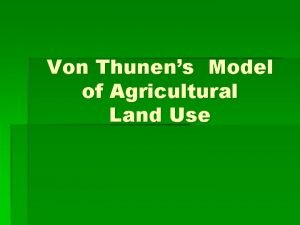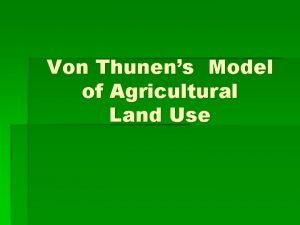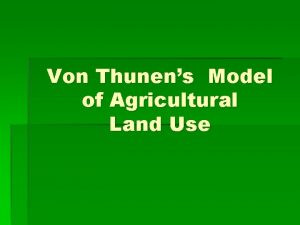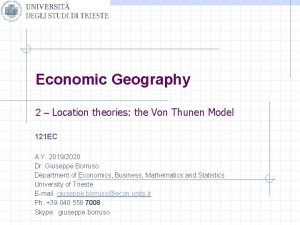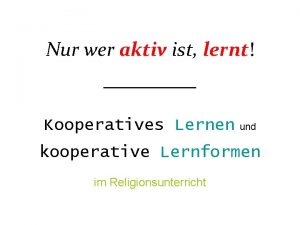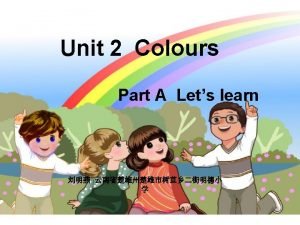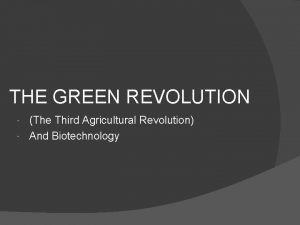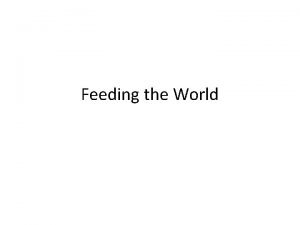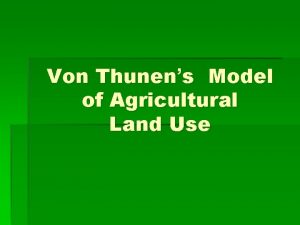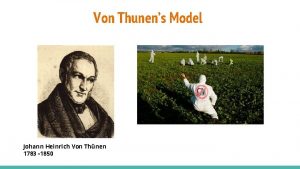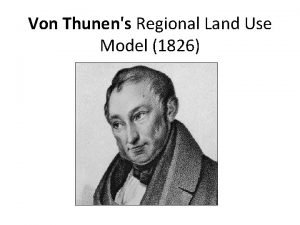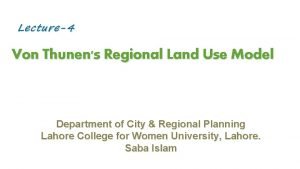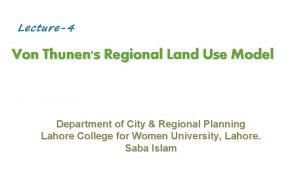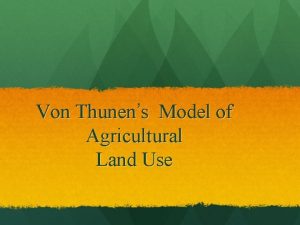VON THUNENS MODEL AND THE GREEN REVOLUTION The










- Slides: 10

VON THUNEN’S MODEL AND THE GREEN REVOLUTION

The Assumptions (1826) • The central city is located centrally within an "Isolated State" • • • which is self-sufficient and has no external influences. The Isolated State is surrounded by an unoccupied wilderness. The land of the State is completely flat and has no rivers or mountains to interrupt the terrain. The soil quality and climate are consistent throughout the State. Farmers in the Isolated State transport their own goods to market via oxcart, across land, directly to the central city. Transport costs thus rise linearly with distance. The selling price for the agricultural products is determined at the market by supply and demand. Farmers act to maximize profits.

The “Central City” • There are four rings of agricultural activity surrounding the city. • Dairying and intensive farming occur in the ring closest to the city. The related • • products (vegetables, fruit, milk and other dairy products) have the highest profits, but also the highest transportation costs because they are vulnerable and perishable. Timber and firewood will be produced for fuel and building materials in the second zone. Before industrialization (and coal power), wood was a very important fuel for heating and cooking. Wood is very heavy and therefore difficult and costly to transport. The third zone consists of extensive field crops such as grain for bread. Since grain lasts longer than dairy products and is much lighter than wood transport costs are considered to be lower, allowing a location further from the city. Ranching is located in the final ring surrounding the central city. Animals can be raised far from the city because they are self-transporting and thus have low transport costs. Beyond the fourth ring lies the unoccupied wilderness (hinterland), which is too great a distance from the central city for any type of agricultural product.

Von Thunen’s Model

Where would you find… • Farmers harvesting wheat? • Cows grazing in a field? • Lumberjacks cutting down trees? • A farmer selling fruits and vegetables? • A dairy farm?

The Green Revolution • Practices • Modified genetics (originally cross breeding, now genetic manipulation) • Fertilizers • Pesticides • Irrigation • Fattening livestock • Capital investments

The Green Revolution • What is it? • Beginning in the 1930 s, American farmers begin using technologically manipulated seeds • Example: • IR 8 – dwarf Chinese rice is crossed with Indonesian rice • Results: bigger head of grain, stronger stem • IR 36 – bred from 13 parent plants • Results: rice is resistant to 15 insects, growing cycle is only 110 days, 3 crops per year in warm climates

The Green Revolution • Around the World • America – 1930’s and 1940’s – corn (maize) • India – 1960’s – rice • Asia – 1970 to 1995 – 67% increase in rice production

The Green Revolution • Factors that encourage success • The revolution came on the scene as the world was waking up to the significant hunger crisis • Increased yield, shorter growing seasons increase food supply • Increased yield leads to greater market presence, trade

The Green Revolution • Factors that limit the success • Emphasis on rice, corn and wheat meant little impact in Africa, where it was most needed • Monocropping (the practice of emphasizing only one crop) leads to vulnerabilities due to weather/insect/nature challenges • Soil erosion due to overfarming • Water shortages due to irrigation demands • Concerns over health risks associated with fertilizers, pesticides and GMOs • Small family farms aren’t competitive in techno-seed agriculture
 Von thunens model
Von thunens model Von thunen model in the us
Von thunen model in the us Von thunen 6 assumptions
Von thunen 6 assumptions Von thunen location theory
Von thunen location theory The third agricultural revolution
The third agricultural revolution Lernpyramide von green & green (2005)
Lernpyramide von green & green (2005) Green green green red
Green green green red Kurshalter
Kurshalter Erasmus von rotterdam beeinflusst von
Erasmus von rotterdam beeinflusst von Green revolution advantages and disadvantages
Green revolution advantages and disadvantages Advantages of green revolution
Advantages of green revolution
